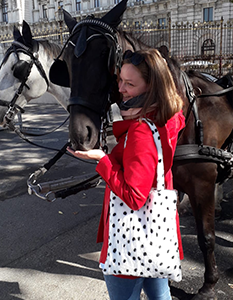Lonneke Delpeut

Lonneke Delpeut
I am a PhD-student at the Institute of Egyptology, specialising in the art history and visual culture of ancient Egypt. I did my BA in Ancient Cultures of the Mediterranean World - Egyptology and my MA in Classics & Ancient Civilisations - Egyptology at the University of Leiden. I’ve spent an Erasmus-semester at the University of Liège in order to specialise further in Egyptian art history and did a 6-month internship at the Egyptian Museum in Turin. My BA-thesis was about the role of the image of the horse as a status symbol in Egyptian private tombs, looking at how images of horses were used by the tomb owners to show how special they were. My MA-thesis specialised more in visual studies and looked at images of horses as a source of information by differentiating what is depicted from how it is depicted. My PhD project proposal is a direct result of the work done in my MA-thesis. I’ve been very luck in being able to combine both my passions for horses and ancient Egypt in my BA and MA-thesis.
Research interests: Visual culture, art history, equine history, ancient Egypt, image studies, Egyptian private tombs, New Kingdom, social history, museum studies, mummy ethics
Current research project: An image is worth a thousand words - how is meaning created in ancient Egyptian tomb decorations in the 18th dynasty in Thebes.
This project aims to find out what the ancient Egyptians tried to convey in painted tomb depictions and how they conveyed it. It does this by identifying the different elements images consist of and how these elements work together to create meaning: image content (what), image execution (how) and the image referent (who).
First of all, it analyses how meaning is created through image content, i.e. what is depicted. It does this by looking at generic features, specifying features and additional features. Secondly, image rendering is studied, i.e. how the image content is made visible. This is done by looking at the image’s formative features, namely detail, form proportions, and spatiality. Lastly, the image referent will be studied, i.e. who, what, when or where is depicted. Image referents are created by using identity markers, which can be textual, co-pictorial, contextual, emblematic or iconic.
This analytical model assesses the creation of meaning on three different levels and how they work together. This approach will give a better understanding of what images are composed of, and what they are trying to convey, and why things look the way they do.
Publications:
- with Willekes, C., 2023, ‘Reality as a Representational Strategy in Depictions of Horses in Ancient Greek and Egyptian Art: How Purpose Influences Appearance’, Arts 2023, 12(2), 57
- 2022, The horse in Ancient Egypt: A Status Symbol or a Status Marker? In: Bohun, H., Husøy, T.A., Furlan, U., Narratives of Power: Proceedings of the University of Wales Institute of Classics and Ancient History Postgraduate Conference, Archaeopress: UK, p. 1-22.
- 2021, ‘What makes a Horse a Horse? Configurational Aspects of Ancient Egyptian Equines’, Cheiron: The International Journal of Equine and Equestrian History: Nov. 2021, Trivent Publishing: Hungary.
